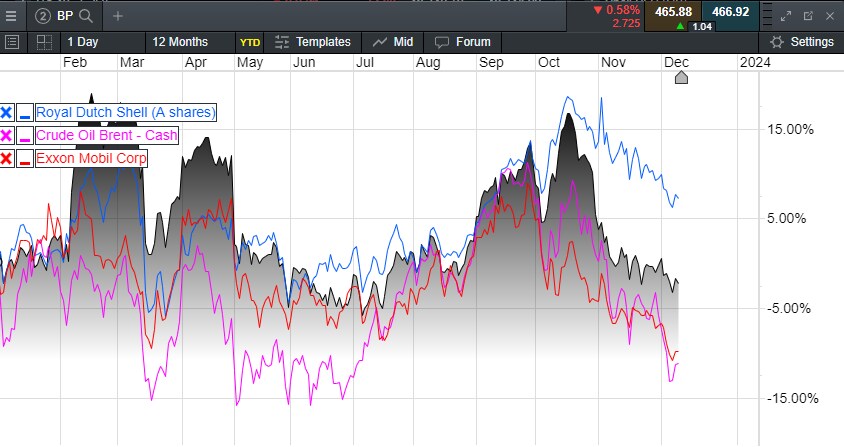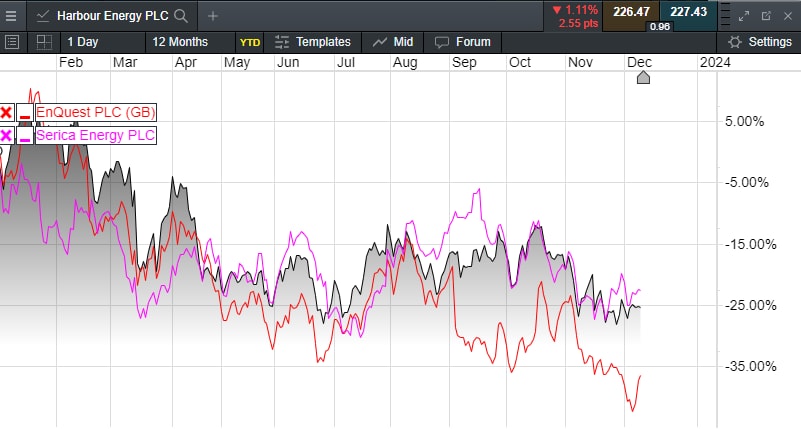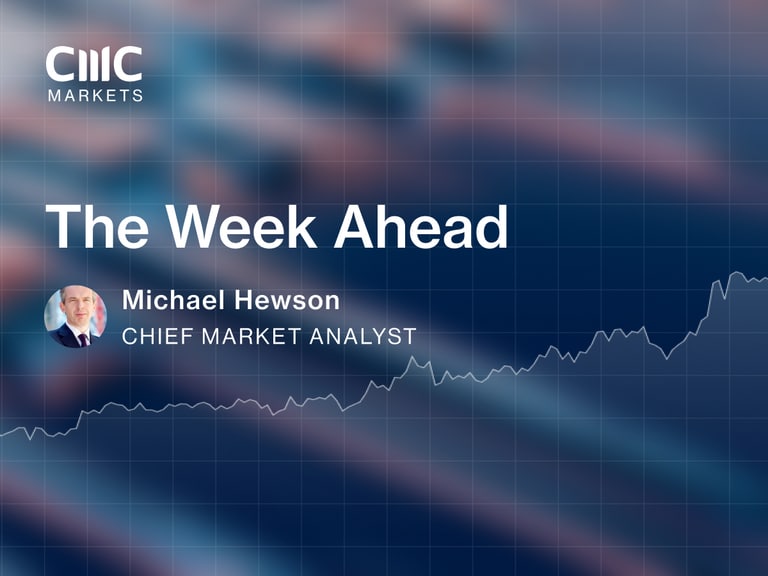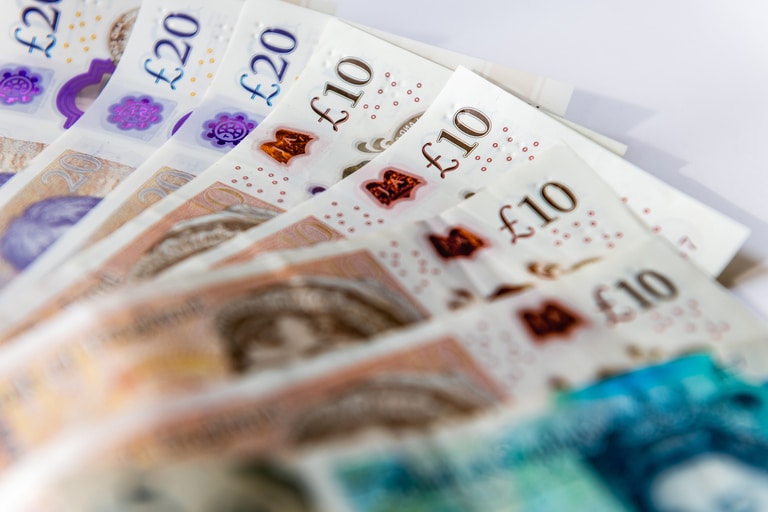In contrast to the strong gains seen in 2022, the oil and gas sector has had a much more mixed year as a sharp fall in natural gas prices, and a slowdown in oil prices, saw profits return to more normal levels for the sector.
In 2022 the likes of Exxon Mobil and Shell saw share price gains in excess of 60%, as both oil giants reaped the benefits of higher margins, as they bounced back from the huge losses posted during the Covid-19 pandemic. As a whole the sector posted losses of $76bn, with around $70bn of that amount as a result of writedowns and impairments on unviable or stranded assets.
As with last year, the challenge for the likes of Exxon Mobil, BP and Royal Dutch Shell remains how they transition towards a renewable future without hammering their margins, and while we’ve seen a period of share price consolidation this year, we’ve also seen a shift in tone away from keeping the green lobby happy. There now seems to be a more hard-nosed and pragmatic approach, which has helped both Exxon and Shell’s share price make new record highs over the second half of the year, although as oil and gas prices have declined, so have share prices.
Consolidation year for BP and Shell

Source: CMC Markets
As a whole, the sector saw demand and prices collapse during that Covid-19 period, and it would appear that those experiences during that time may have shaped Opec’s response to this year’s supply and demand concerns. Fearing another oversupply issue, Opec and Russia have kept much tighter control over production output, announcing cuts in April and then continuing those caps through the summer and into next year in an attempt to keep a floor under prices.
Along with further geopolitical uncertainty on top of Russia’s war in Ukraine, in October we also had to contend with Hamas' savage attack on Israel’s northern border, and Israel’s response which prompted concerns over transit routes around the Gulf region.
With inflationary pressures subsiding and energy prices stabilising at lower levels, the oil and gas sector for now appears to focusing on what it does best in generating cash, with new CEOs for both Shell and BP marking a potential shift in thinking when it comes to renewables. Under their previous incumbents, Shell’s Ben Van Buerden and BP’s Patrick Looney, the focus was very much on transitioning away from oil and gas and towards a much lower margin future of renewable energy. While a laudable goal, it soon became apparent that while the politics was very much geared to that, there was a growing realisation that it couldn’t be done cheaply and not without enormous damage to the collective energy and economic security.
Shell
When Wael Sarwan took over as CEO of Shell he recognised this reality quickly, pushing back against the prevailing narrative and outright hysteria of politicians and activists that it could be done cheaply and easily. In June he pushed back by saying that: "We need to continue to create profitable business models that can be scaled at pace to truly impact the decarbonisation of the global energy system. We will invest in the models that work – those with the highest returns that play to our strengths", in a broadside at some of the recent reckless narrative and almost hysterical calls to cut back on fossil fuel use whatever the cost.
While this has caused some unease in some parts of the Shell business, it appears to be an acknowledgment of the reality that the transition to renewables will be a gradual process, especially given the current levels of geopolitical uncertainty that are serving to drive the costs of the energy transition ever higher. It is a little worrying that politicians have been unable to grasp this reality, continuing to push the myth that wind power is cheap, as the silent majority push back over the reality that the transition will be ruinously expensive if done too quickly.
When Shell reported its Q2 numbers in July, profits fell short of expectations due to the sharp falls in both natural gas and crude oil prices that occurred over that quarter. The rally in oil and gas prices since then has ensured that this didn’t happen in Q3 with profits coming in line with forecasts, which given that all its peers saw their numbers come in light was particularly notable.
Q3 profits came in at $6.22bn, in line with expectations helped by improvements in refining margins as well as higher oil and gas prices and a better performance in its trading division. The integrated gas part of the business saw profits remain steady and were in line with Q2 at $2.5bn. Upstream saw a solid improvement on Q2’s $1.68bn, rising to $2.22bn, although we’ve still seen a steep fall from the same quarter last year.
On renewables we saw that part of the business sink to a loss of -$67m, due to lower margins and seasonal impacts in Europe, as well as higher operating expenses.
Shell’s chemicals and products division also did much better in Q3, its profits rising to $1.38bn helped by an improvement in refining margins due to lower global product supply as well as higher margins in trading and optimisation, although chemicals were still a drag on profitability overall.
On the outlook Shell nudged the upper end of expectations for capital expenditure down by $1bn to between $23bn to $25bn, as well as increasing the buyback to $3.5bn. While Shell’s share price has held up reasonably well the same can’t be said for BP which while holding onto last year’s gains has lagged behind Shell, although BP was able to get close to its February highs in the middle of October.
BP
Here the company has been hit by management upheaval as first CEO Bernard Looney departed after failing to disclose details of past relationships with colleagues, and was then followed out the door by the head of BP’s US operation Dave Lawler also resigned. Nonetheless the uncertainty at the top of the UK’s second biggest oil company helps to explain why BP’s share price has underperformed relative to Shell in the last this year, however it doesn’t explain why it has underperformed year to date. That’s down to management and it rather begs the question as to whether any new CEO will persevere with the “Performing while Transforming” of Bernard Looney, because while it is clear that BP is transforming, it certainly isn’t performing, after missing on Q3 profits.
When BP reported in Q2 the numbers were clearly expected to come in short of expectations, and while the bar was low, they still somehow failed to clear it. The Q3 numbers followed the same playbook with underlying replacement cost profit coming in at $3.3bn, falling well short of expectations of $4.05bn.
The underperformance appears to have come from its gas and low carbon energy division where profits were lower compared to Q2 at $1.25bn, while oil production and operations saw an increase from Q2, coming in at $3.13bn, although both numbers were sharply lower from the levels last year due to lower oil and gas prices. One of the reasons for the sizeable drop in profits in the gas and low carbon energy division is the decision to take a $540m charge in respect of its joint share with Equinor in a US offshore wind farm off the coast of New York.
In a carbon copy of Q2, BP took the decision to try and sweeten the disappointment by announcing another $1.5bn buyback, while announcing a dividend of 7.27c a share. Despite the disappointment the headline numbers are an improvement on Q2 and appear to be in line with the misses seen from its US peers Chevron and Exxon, however these two US oil majors are magnitudes of size bigger so the bar for them is higher. Reported oil production levels are also higher from the same quarter a year ago, up by 5%
On the plus side BP has managed to cut the level of its debt by $1.3bn to $22.3bn, however this only partially reverses the decision to increase it in Q2 by $2bn to fund an increase in the dividend and announce another buyback. For Q4 BP said it expects upstream production to be broadly flat compared to Q3, while also saying it expects to see lower volumes as well as pressure on refining margins.
While the likes of BP and Shell have managed to hold up reasonably well this year, the same cannot be said for the smaller UK oil and gas giants who have seen their profits wiped out by the UK government’s misguided 35% windfall tax, which has to all intents and purposes killed investment in the North Sea basin and surrounding region.
Harbour, Serica Energy and EnQuest share price year-to-date

Source: CMC Markets
To illustrate this point perfectly, back in August Harbour Energy announced that H1 revenues came in at just over $2bn, down from $2.67bn a year ago on the back of lower oil and gas prices. Profit before tax fell from $1.49bn last year to $429m this year, though after tax of $437m, this translated into a H1 net loss of -$8m, compared to a $984m profit last year. Of the revenues, $1.11bn came from crude oil, and gas of $759m, with the bulk of sales coming from its North Sea operations. International revenue accounted for a mere $98.1m in sales.
The company announced an interim dividend of $100m or 12c a share, while saying that they expected to reach zero net debt by the middle of next fiscal year. This is a significant achievement given that at the time of the Premier Oil and Chrysaor merger, the company was carrying net debt of $2.9bn.
Due to the windfall tax, CEO Linda Cook said that the review of their UK operations had delivered annual savings of $50m from 2024, with Harbour growing its share of UK domestic oil and gas to 15%. Harbour also announced they would be reducing annual capex to $1bn as well as guiding production guidance lower to 195kboepd.
During the summer the UK government tried to throw a bone to the sector by saying the windfall tax would cease to apply if average prices for oil and gas fell to, or below $71.40 a barrel, and £0.54p a therm for two consecutive quarters, the tax measure would cease to apply and revert to 40%. While the UK government has announced it will be offering hundreds of new licences for oil and gas production uptake, with 27 approved in October, most of these are unlikely to come on stream quickly.
As we look ahead to 2024, the likes of BP and Shell can certainly be criticised for a lack of investment towards renewables and incentivising buybacks over future capex, but oil companies will only invest large amounts of capital or sunk costs if they have an expectation of a decent return, and a stable investment environment. Currently we have neither of these, and in the case of renewables there is little in the way of profit to be made to justify the large capital outlay, which is why a recent government offshore wind auction didn’t attract any bids, due to a low strike price.
When that maximum strike price was raised from £44MWh to £73MWh for offshore, and from £116MWh to £176MWh for floating offshore wind, the auctions attracted great interest.
The economics of renewables appears to be something that eludes the imagination of a lot of people, not only in politics, but also in the general population. Until that changes, it will be extremely difficult if not impossible to be able to implement the sort of changes required in the timeframe that is required. Even the more established players in the renewables sector are struggling to turn a profit when it comes to wind and solar power.
Denmark’s Orsted for example is one of the world’s biggest providers of renewable energy of offshore wind, with an excess of 13.7GW of installed capacity, with 6.2GW of that installed in the UK. This total is expected to increase to 50GW by 2030, by a combination of wind, solar and renewable hydrogen, which last year was estimated to cost in the region $54bn. Since then, the prices of key commodities have soared, along with demand. This inconvenient fact continues to be overlooked by climate activists as they continue to peddle the fiction that renewable power is cheaper.
The reality is that oil and gas is likely to be around for some time to come in the absence of a reliable base load alternative which can compensate for 'dunkelflaute' periods of low light and no wind, which occurs on average between 50-100 hours a month between November and January.
Disclaimer: CMC Markets is an execution-only service provider. The material (whether or not it states any opinions) is for general information purposes only, and does not take into account your personal circumstances or objectives. Nothing in this material is (or should be considered to be) financial, investment or other advice on which reliance should be placed. No opinion given in the material constitutes a recommendation by CMC Markets or the author that any particular investment, security, transaction or investment strategy is suitable for any specific person. The material has not been prepared in accordance with legal requirements designed to promote the independence of investment research. Although we are not specifically prevented from dealing before providing this material, we do not seek to take advantage of the material prior to its dissemination.






